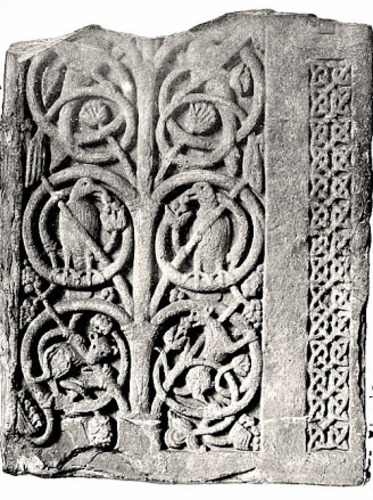The Four Great Rutherford Churches
The Four Great Rutherford Churches
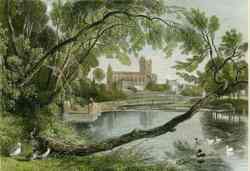
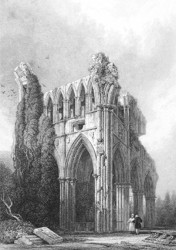
Jedburgh Abbey
The Rutherford home church and ancestral burial place of the Clan is an Augustinian abbey, in the town of Jedburgh, capital of Roxburghshire, Scotland. Jedburgh Abbey was established as a priory by David I, King of Scots, in 1118, and colonized by Canons Regular of St. Augustine from the Abbey of St-Quentin, at Beauvais, France. Fordun gives 1147 as the year of foundation, but this seems to have been the date of the erection of the priory into an abbey, when prior Osbert (styled in the Melrose chronicle "primus abbas de Geddeworth") was raised to the abbatial dignity. Jedburgh soon became one of the greatest Scottish monasteries, deriving importance from its proximity to the castle (now entirely destroyed), which was the favourite residence of many of the Scottish kings. Lands, churches, houses, and valuable fisheries, on both sides of the border, were bestowed on the abbey by David I, Malcolm IV, William the Lion, and other royal and noble benefactors; and Alexander III chose to be married in the abbey church to Yolande de Dreux in 1285, by which year the monastic buildings, including the great church, were probably complete.
An opulent abbey so near the English border as Jedburgh was sure to suffer much in the constant wars between England and Scotland. About 1300 the monastery became uninhabitable, owing to repeated attacks made on it, and the community was dispersed. Later on it recovered its prosperity for a time, but in the century and a half preceding the Reformation it was devastated, plundered, and occasionally set on fire, at least four times by the invading English. In 1559 (John Horne being abbot) the abbey was suppressed, and its possessions confiscated by the Crown. A Protestant church was afterwards constructed within the nave and used until 1875, when a new church was built by the Marquess of Lothian, whose family has possessed the lordship of Jedburgh continuously since 1622. Practically the whole of the domestic buildings of Jedburgh Abbey have disappeared; but the magnificent church is still wonderfully entire. The oldest part is the early Norman choir, of which the two western bays remain; and the nave, 129 feet long, is a very stately and impressive example of Early English work. The Rutherfords are buried in the nave and choir area. The decorated north transept (fourteenth century) is the burial-place of the Kers of Fernihurst, now represented by the Marquess of Lothian. The massive central tower is still quite perfect. The total length of the church (inside) is 218 feet.
On July 13th, 1464, the Abbot of Jedburgh granted a right of burial in the Abbey to Robert Rutherford of Chatto and his wife Margaret [son of our George Rutherfurd of Chatto and his wife Janet Rutherfurd of Edgerston]. The whole of the choir was afterwards divided among the Rutherfords as their burial place, and allotments were assigned for the Rutherfords of Edgerston, Hunthill, Hundalee, Fairnington, Hall and Bankhead. The last Rutherford of note to be buried in the Abbey was Sir John Rutherfurd of Edgerston. Many of the grave markers are still standing and there is a crypt set aside for the family.
The north transept of Jedburgh Abbey was set aside as a burial area for the Kerr family sometime after 1545. In that year, Sir Andrew Ker died and was the first of the family to be buried in the Abbey. His tombstone incorrectly reads "1524". He was captured by the English in 1523 and knighted in 1543. He was Warden of the Middle Marches.
Sir John Ker of Ferniehirst, Warden of the Middle Marches, is also buried there. Knighted in 1548, he fought for the English cause. His son Sir Thomas Ker [also Warden of the Middle Marches - Provost of Jedburgh and Edinburgh] supported Mary Queen of Scots and is buried in Aberdeen- he died in 1562 even though his stone says 1559.
Sir Andrew Ker, eldest son of Sir Thomas Ker of Ferniehirst received a charter under the great seal in 1587 confirming his office as Bailie of Jedburgh held by his father and grandfather. He served as provost of Jedburgh. He was raised to the peerage in 1622 with the title of Baron of Jedburgh. He died in 1631. He is buried under the great window in Jedburgh Abbey and his arms are displayed.
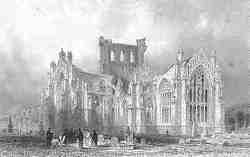
Dryburgh Abbey
A monastery belonging to the canons of the Premonstratensian Order (Norbertine or White Canons), situated four miles south-east of Melrose, Scotland. It was founded about 1150 by Hugo de Morville, Constable of Scotland, who brought a community from Alnwick in Northumberland. The situation is beautiful, a wooded promontory, around three sides of which sweeps the River Tweed. The church was dedicated to the Blessed Virgin. The first Abbot of Dryburgh was Roger, whose surname is not recorded. Abbot Roger brought the Praemonstratensian Monks from Alnwick to Dryburgh, and established the first home in Scotland for the "white canons" in 1152, so named for the colour of their robes. The monastery was burnt to the ground by Edward II, who encamped in the grounds when retreating from Scotland in 1322. It is believed the English forces were retreating after Edward II's second unsuccessful invasion of Scotland, when they heard the premature ringing of the bells of Melrose and Dryburgh Abbeys. The troops, on hearing them, retraced their steps and burnt both buildings. The Abbey was restored under Robert I, who himself contributed largely. At the Dissolution it was created a temporal lordship, and conferred by James VI on the Earl of Mar, who made it over to his third son, ancestor of the Earl of Buchan. It has again come into the hands of the last-named family in recent times by purchase.
The Abbey was repaired, but suffered again and again, falling victim to the constant Border raids and skirmishes until it was finally burnt down on November 9, 1544 during Henry VIII's "Rough Wooing", the name given to the punitive invasion of his son to Mary, Queen of Scots. The brutality of instructions to Henry's brother-in-law Hertford rings out over the years "His Majesty's pleasure is that you shall ..... put all to fire and sword, burn Edinburgh town, so razed and sacked and gotten what ye can of it as there may remain forever a perpetual memory of the vengeance of God".
The Abbey was never rebuilt, the number of monks slowly dwindled until the active religious life of the Abbey ended. Stone was plundered by the locals for building material until the ruins were protected by the Erskine family who acquired the Abbey.
The general style of the existing remains of Dryburgh is Early English, with some older (Norman) work. Of the church only the western gable, the ends of the transept, and part of the choir remain; but considerable portions of the conventual buildings have been preserved, including the refectory, with a beautiful rose window. James Stuart, of the Darnley family, is buried under the high altar; and various members of the Buchan family lie in one of the chapels. The principal object of interest to visitors is the tomb of Sir Walter Scott, in St. Mary's Aisle (part of the north transept). Sir Walter's maternal grandparents, the Haliburtons, at one time owned Dryburgh. His wife and eldest son are also interred here.
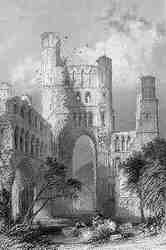
Melrose Abbey
Founded in 1136 by King David I, Melrose Abbey was the earliest Cistercian monastery established in Scotland. Its first community came from Rielvaux, the Yorkshire house colonized from Cîteaux. In less than ten years St. Mary's Abbey, Melrose, had been completely built. It stood in a broad glen south of the Tweed, two miles distant from the Celtic monastery of Old Melrose, where St. Cuthbert had lived five centuries before. Melrose Abbey suffered greatly from hostile incursions of more than one English monarch; the soldiers of Edward II desecrated, pillaged, and burned the church; Richard II in 1385 laid waste the surrounding country and set fire to the abbey. Mainly through the generosity of Robert the Bruce, a more stately church was begun in 1326, and scarcely completed by the sixteenth century.
Not only the royal founder, but succeeding sovereigns, and countless benefactors, nobles and commoners, so richly endowed Melrose with lands and possessions. Many of the abbots were men of distinction: Abbot Waltheof (1148), stepson of David I, and honoured as a saint; Abbot Joscelin, afterwards Bishop of Glasgow (1175), took a prominent part in the erection of the fine cathedral of that city, as a shrine for the body of St. Kentigern; Abbot Robert (1268) had been formerly Chancellor of Scotland; Abbot Andrew (1449) became Lord High Treasurer; many others were raised to the position of bishop.
The English troops of Henry VIII burned Melrose in 1544. Although the monks once numbered two hundred, and there were one hundred and thirty as late as twenty years before the Reformation, eleven only received pensions at the dissolution. The possessions of the abbey came finally to the Buccleuch family, the clan chieftains of the Scotts. The ruins were further devastated by a fanatical mob in 1569, when statues and carvings were ruthlessly destroyed; but more wanton still was the subsequent carting away of the sacred stones in great numbers to serve as building materials. The result is seen in the carved religious emblems still appearing upon surrounding houses.
Kelso Abbey
The order established at Kelso was that of the Tyronenses, so called from Tyron, a town of Picardy, in the north of France. There was the head establishment of the order of which Robert of Abbeville was the founder (1109). Among the Tyronenses there were found skilful farmers, expert carpenters and smiths, while others of the order excelled in the arts of architecture and drawing. The abbey was built under stewardship of David I in 1128 and became the wealthiest of the Border Abbeys. James III was crowned here as an infant. It was destroyed in the 16th century and now lies in ruins, although it retains much of its superb architecture. It stands next to the confluence of the Tweed and the Teviot Rivers. It was, even more than Jedburgh, on the great highway of war, and suffered from Edward and his soldiers.
The Tyronensian Abbey of Kelso was endowed with lands in Peeblesshire and other parts of Scotland. The See of York strove to subject it to its jurisdiction, and exercise metropolitan power over it. The dispute was referred to Rome, and the reigning Pope, Alexander III., decided in favor of its independence, and soon thereafter the abbey rose to eminence, and planted itself out in the other monastic houses. The great Abbey of Arbroath was supplied with monks from Kelso, and was at its beginning a dependency of the southern establishment. The other offshoots of Kelso were Lesmahagow, Lindores, and Kilwinning.
The canons-regular of St. Augustine were the first to arrive in Scotland, in the year 1114, in their white tunics and black gowns. In twenty years since their first coming into the country, we find the Augustinians at Scone, at St Andrews, at Holyrood, at Inchcolm, and at other places. Eventually they had twenty-seven houses in Scotland.
After the Augustinians came the Red Friars or Redemptorists, founded 1198; the Black Friars or Dominicans, founded 543; the White Friars, or Carmelites, who hailed originally from Mount Carmel. There followed by the Premonstratenses from Premontre in France, the Cluniacenses from Clugny, the Benedictines, the Tyronenses, the Cistercians, the Carthusians, and the Franciscans. King David also introduced into his kingdom the military orders of the Knights Hospitallers, the Knights Templars, and the Lazarists of Jerusalem.
Saint Kentigern's Stone
